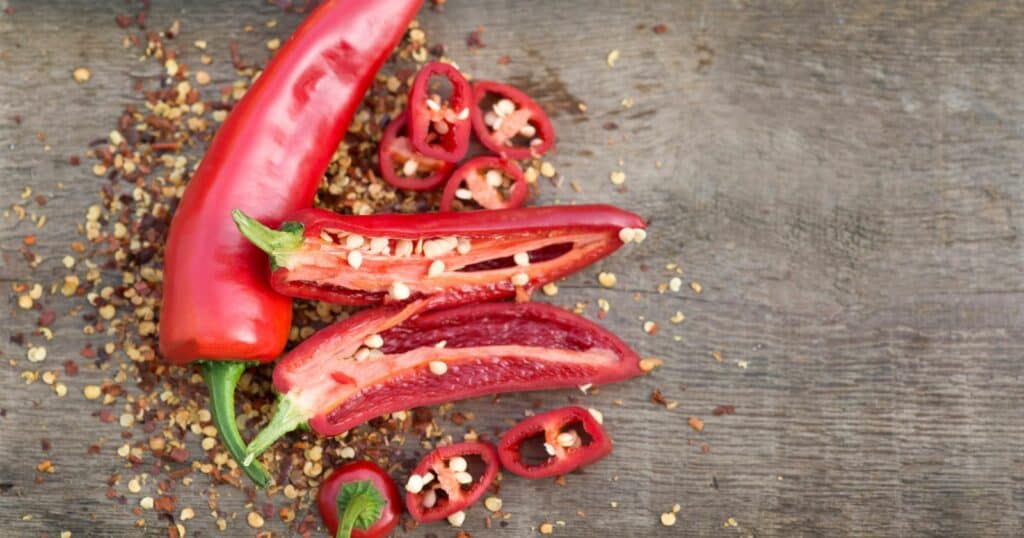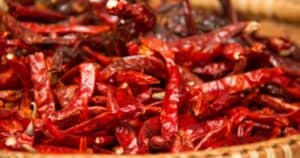Have you ever taken a bite of a spicy pepper and felt like your mouth was on fire? If so, you’re not alone. Many chili lovers ask themselves: what part of the pepper is spicy? Knowing which components pack the most heat can help you control the burn when cooking.
As a lover of bold, spicy foods myself, I used to think the seeds were the key source of a pepper’s trademark sizzle. But after digging into pepper anatomy, I uncovered that the true heat hideout lies inside the inner white membrane, not the seeds.
The membrane surrounding the seeds, also called the placenta or placental tissue, contains the highest concentration of capsaicin—the potent chemical compound that puts the
In contrast, the seeds themselves harbor no capsaicin and are not actually spicy. This explains why sweet peppers like bell peppers have zero heat—they lack placental tissue altogether.
As peppers grow and mature, their
Now that you know the secrets behind a pepper’s burn, you can better control the fire and
Let’s turn down the burn or ignite the sizzle according to your personal tolerance. A world of flavor awaits your discovering tastebuds!
The Spicy Secret Lies in the Seeds and Inner Membrane

Contrary to popular belief, the seeds themselves do not contain the chemical compound that makes peppers spicy. The true source of a pepper’s heat is actually the white membrane surrounding the seeds, aptly called the placenta or placental tissue.
This thin white membrane houses most of the capsaicin, the potent compound responsible for that burning sensation when you bite into a chili pepper. Along with the placental tissue, the flesh of hot peppers contains smaller amounts of capsaicin.
In contrast, sweet bell peppers lack placental tissue altogether which explains their total absence of
Capsaicin Causes the Heat
Capsaicin is what makes chili peppers pungent and spicy. This naturally occurring chemical irritates and inflames the pain receptors in your mouth, nose, and throat when eaten. The hotter the pepper, the more capsaicin it contains.
The scale of “heat” in peppers is measured in Scoville Heat Units (SHUs), which gauges the concentration of capsaicin. Bell peppers rank at 0 SHUs with no heat, while the super-hot Carolina Reaper maxes out at a blistering 2.2 million SHUs!
When cooking with hot peppers, remember that capsaicin is highly concentrated in the placental tissue but also present in the flesh. Removing the seeds can temper the heat slightly, but for a truly mild dish, stick with naturally sweet peppers.
Peppers Gain Heat as They Mature
Another factor impacting the spiciness of peppers is their maturity level. As peppers grow and ripen, they progressively get hotter.
Immature jalapeño peppers first emerge green with very little heat. As they ripen to red, their capsaicin content increases substantially. Fully mature red jalapeños are significantly spicier than the younger green ones.
The same applies to habaneros and other chili peppers. Allowing peppers to fully ripen on the vine results in the hottest flavors. Pick your peppers early if you prefer a milder
Dry Spice Blends Add Extra Heat
Beyond fresh peppers, powders made from ground dried peppers can provide an added punch of heat and aroma. Chili powder and cayenne pepper, for example, are both spices frequently used to make dishes spicy.
Paprika is another dried pepper product that ranges from sweet and mild (like smoked paprika) to spicy and robust (like Hungarian paprika). When shopping for these dry spices, read the label closely to understand what type of peppers were used to make the blend. This will give you a sense of how hot it will taste.
Parts of Peppers That Aren’t Spicy
While the placental membrane and flesh contain fiery capsaicin, other parts of chili peppers harbor no heat at all:
- Seeds – Contrary to popular belief, the seeds themselves do not contain capsaicin and are not too much spicy. Removing seeds will lower the heat level mildly by eliminating some placental tissue, but the seeds on their own are not a source of
spice . - Skin – The outer skin or peel of hot peppers does not contain much capsaicin. However, some heat can transfer if you touch the skin then rub your eyes. Use gloves when handling hot peppers to avoid this effect.
- Stem – The stems of chili peppers are entirely safe to handle and eat. They contain zero capsaicin. Chop off and discard pepper stems before cooking to eliminate any tough, fibrous textures.
- Roots – Pepper plants draw capsaicin through their roots where it accummulates in the placental membranes and flesh. However, the roots themselves do not produce or contain any of the heat-inducing compound.
So feel free to handle, eat or remove any of these non-spicy pepper parts to adjust heat and texture as desired. Just be sure to keep the white membrane intact if you want to retain the full spicy impact!
Cooking Tips to Control the Burn
Now that you know exactly where the heat comes from in peppers, here are some useful tips to control spiciness when cooking:
- Remove the ribs and seeds to reduce some heat.
- Soak peppers in milk; the caseins bind to capsaicin.
- Avoid putting bare hands near your eyes after handling hot peppers.
- Add a fat like olive oil to help curb the burn.
- Balance hot peppers with cool yogurt or sour cream.
- Drink milk to tame the flame; caseins again bind to capsaicin.
- Add sugar or sweet fruits to counter the heat.
- Douse your tongue with bread, rice, or starch to absorb capsaicin.
Understanding the source of
Is It Safe to Touch the Hot Parts with Bare Hands?
When cooking with peppers, you’ll inevitably need to handle the spicy placental membrane and flesh. But is it actually safe to touch these fiery parts with bare hands?
While your skin won’t feel the “burn” from capsaicin, you should still take precautions:
- Use gloves when handling hot peppers to keep the oils off your skin completely.
- Avoid touching your eyes, nose or mouth after handling hot peppers until you wash your hands thoroughly with soap and water.
- Capsaicin can stick to skin for hours, so wash hands before eating or touching sensitive areas.
- If irritation occurs, rinse hands in cold milk or apply vegetable oil, which helps lift capsaicin.
- Wash cutting boards immediately after use to prevent transfer of oils.
So while the pepper itself won’t damage your skin, the capsaicin oils can spread easily and cause temporary pain and inflammation. For comfortable handling, gloves and proper cleanup are key!
The next time your dish needs a little fire, look to the placental tissue and flesh of mature peppers. Just be sure to balance the heat with cooling foods to prevent scorched taste buds!





